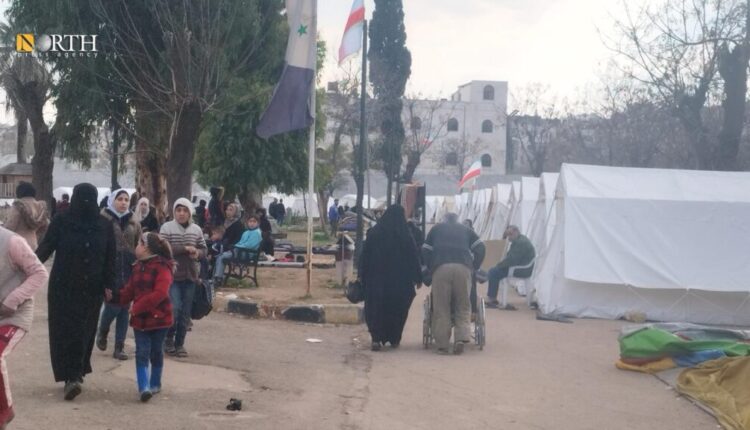
ALEPPO, Syria (North Press) – “We live on the charity of good people. The governing authority [Syrian government] is good for nothing. Our tents were sent from Iraqi people,” Hala Hadad, 38, from Bustan al-Qaser, a neighborhood in Aleppo, northern Syria, said.
Hadad lost her home in the Bustan al-Qaser in the earthquake and now she lives with her daughter in a tent near al-Zubadiyah Bridge, in Jab al-Jalabi neighborhood.
She wonders, “How can they say we are living if we do not have a house, clothes, or even basics of life?”
Hadad, like other quake-affected people, did not receive any support or aid from the government to help them return to normal life.
She noted that all she has is a tent “with a cold floor and swaying walls.”
She told North Press, “teams from the governorate [authorities] came and took surveys and have not returned yet. I applied for a rental allowance grant through the Chamber of Industry and did not receive it.”
She speculated that the reason for this is “nepotism even in humanitarian actions.”
Justification
Luai Assi, a pseudonym for an official in the Chamber of Industry, justified not giving rental allowance to all quake-affected people, because ” the chamber collected donations from manufacturers,” Assi said, “We received sums even from outside of Syria, but we are not a government and unable to provide substitute rented residences to all the affected. So far, we have reached 790 families and helped them through donations after the earthquake.”
The Engineers Syndicate in Aleppo, affiliated with the government, formed about 115 committees, which included 269 specialized engineers, to cooperate with the city council to inspect damaged buildings and allow residents to safely return to their houses.
According to the reports of the Committee’s teams, 23,921 buildings were inspected since mid-March, and 877 need to be demolished.
413 high-risk buildings were demolished and 5,301 are in need of reinforcing. The number of intact buildings after inspection is 17,743, while the number of families evacuated from their homes is 863.
At the end of March, an exclusive source from the Aleppo City Council told North Press that it was early to talk about the reconstruction of new housing for those affected by the earthquake in the city.
He noted that the idea of building housing for those affected “may take years,” and that the council does not have mechanisms to carry out the rubble from narrow streets in the affected neighborhoods.
Absent aid
Saeed Abdulraauf, 50, lost his job at a leather dyeing factory in the industrial area of al-Ramosa, southern Aleppo, after it collapsed. He does not have another source of income to provide for his family.
Abdulraauf, an affected resident of the al-Salihin neighborhood, wonders, “where did the massive aid that arrived in government-held areas go, as those affected are in their worst living conditions?”
Large quantities of humanitarian assistance sent to the affected people from Arab and European States reached areas under the control of the Syrian government, however, the beneficiaries were “few”, according to people in the affected areas.
